2011 KIA Soul Exhaust
[x] Cancel search: ExhaustPage 300 of 356

Maintenance
20
7
AUTOMATIC TRANSAXLE FLUID (IF EQUIPPED)
G100100BUN-C1
Checking the automatic transaxle
fluid level
The automatic transaxle fluid level
should be checked regularly.
Keep the vehicle on the level ground with
the parking brake applied and check the
fluid level according to the following pro-
cedure.
1. Place the shift lever in N (Neutral) posi-
tion and confirm the engine is running
at normal idle speed.
2. After the transaxle is warmed up suffi- ciently [fluid temperature 70~80°C
(158~176°F)], for example by 10 min-
utes usual driving, move the shift lever
through all positions then place the
shift lever in N (Neutral) or P (Park)
position. 3. Confirm if the fluid level is in the "HOT"
range on the level gauge. If the fluid
level is lower, add the specified fluid
from the fill hole. If the fluid level is
higher, drain the fluid from the drain
hole.
4. If the fluid level is checked in cold con- dition [fluid temperature 20~30 °C
(68~86 °F)], add the fluid to the “C”
(COLD) line and then recheck the fluid
level according to the above step 2.
✽ ✽
NOTICE
“C” (COLD) range is for reference only
and should NOT be used to determine
transaxle fluid level.
WARNING - Transaxle fluid
The transaxle fluid level should be
checked when the engine is at nor-
mal operating temperature. This
means that the engine, radiator,
radiator hose and exhaust system
etc., are very hot. Exercise great
care not to burn yourself during
this procedure.
WARNING- Parking brake
To avoid sudden movement of the
vehicle, apply parking brake and
depress the brake pedal before
moving the shift lever.
CAUTION
Low fluid level causes transaxle
slippage. Overfilling can causefoaming, loss of fluid and transaxlemalfunction.
The use of a non-specified fluid could result in transaxle malfunc-tion and failure.
OAM079009OSA077009
HOT
COLD
Page 334 of 356
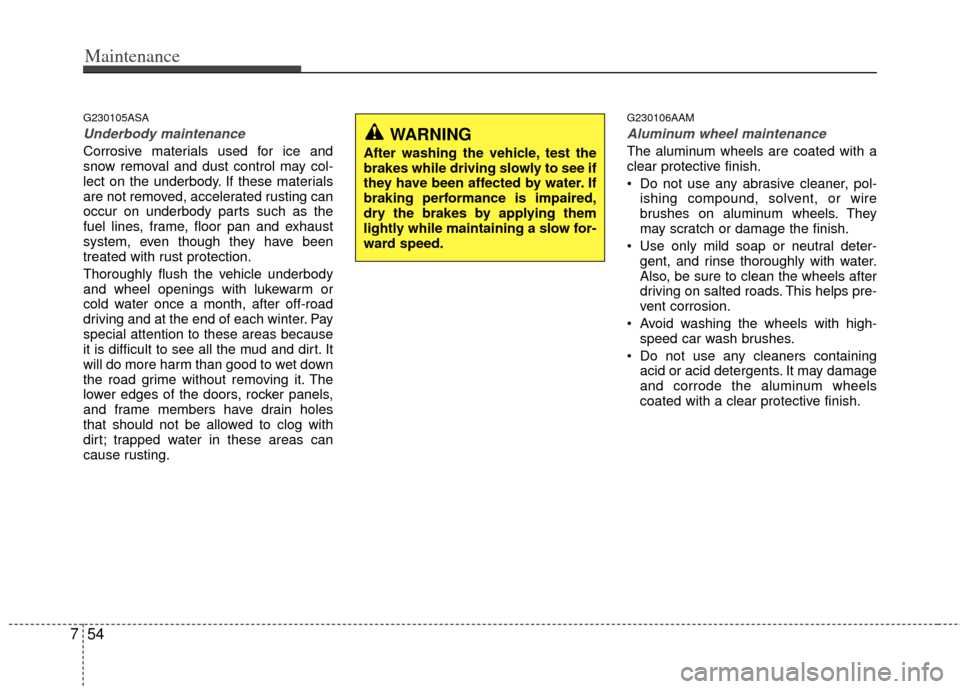
Maintenance
54
7
G230105ASA
Underbody maintenance
Corrosive materials used for ice and
snow removal and dust control may col-
lect on the underbody. If these materials
are not removed, accelerated rusting can
occur on underbody parts such as the
fuel lines, frame, floor pan and exhaust
system, even though they have been
treated with rust protection.
Thoroughly flush the vehicle underbody
and wheel openings with lukewarm or
cold water once a month, after off-road
driving and at the end of each winter. Pay
special attention to these areas because
it is difficult to see all the mud and dirt. It
will do more harm than good to wet down
the road grime without removing it. The
lower edges of the doors, rocker panels,
and frame members have drain holes
that should not be allowed to clog with
dirt; trapped water in these areas can
cause rusting.
G230106AAM
Aluminum wheel maintenance
The aluminum wheels are coated with a
clear protective finish.
Do not use any abrasive cleaner, pol-
ishing compound, solvent, or wire
brushes on aluminum wheels. They
may scratch or damage the finish.
Use only mild soap or neutral deter- gent, and rinse thoroughly with water.
Also, be sure to clean the wheels after
driving on salted roads. This helps pre-
vent corrosion.
Avoid washing the wheels with high- speed car wash brushes.
Do not use any cleaners containing acid or acid detergents. It may damage
and corrode the aluminum wheels
coated with a clear protective finish.
WARNING
After washing the vehicle, test the
brakes while driving slowly to see if
they have been affected by water. If
braking performance is impaired,
dry the brakes by applying them
lightly while maintaining a slow for-
ward speed.
Page 338 of 356
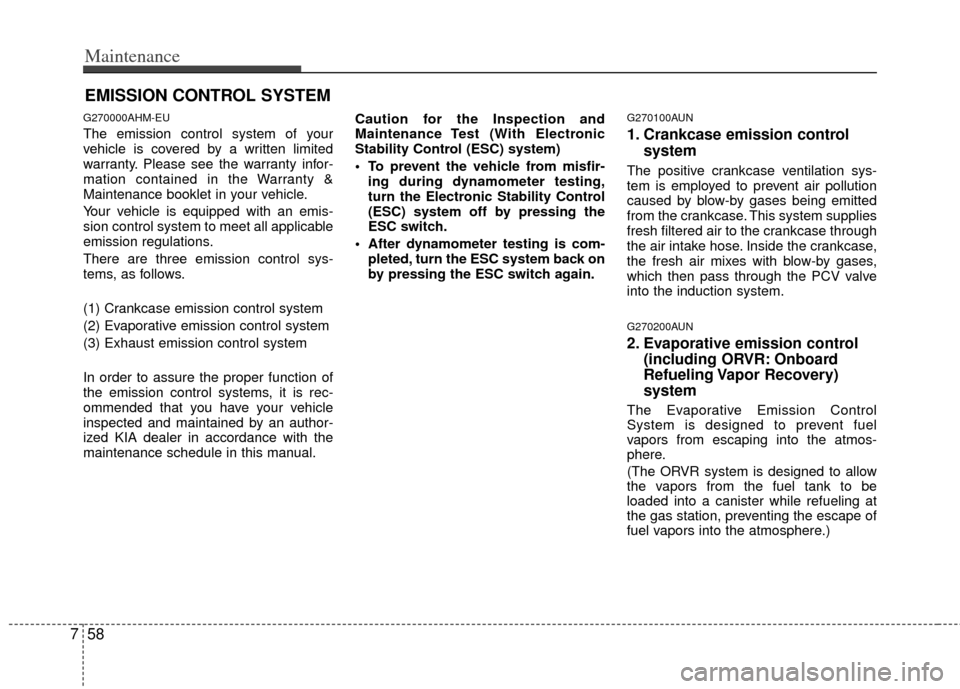
Maintenance
58
7
EMISSION CONTROL SYSTEM
G270000AHM-EU
The emission control system of your
vehicle is covered by a written limited
warranty. Please see the warranty infor-
mation contained in the Warranty &
Maintenance booklet in your vehicle.
Your vehicle is equipped with an emis-
sion control system to meet all applicable
emission regulations.
There are three emission control sys-
tems, as follows.
(1) Crankcase emission control system
(2) Evaporative emission control system
(3) Exhaust emission control system
In order to assure the proper function of
the emission control systems, it is rec-
ommended that you have your vehicle
inspected and maintained by an author-
ized KIA dealer in accordance with the
maintenance schedule in this manual. Caution for the Inspection and
Maintenance Test (With Electronic
Stability Control (ESC) system)
To prevent the vehicle from misfir-
ing during dynamometer testing,
turn the Electronic Stability Control
(ESC) system off by pressing the
ESC switch.
After dynamometer testing is com- pleted, turn the ESC system back on
by pressing the ESC switch again.
G270100AUN
1. Crankcase emission control system
The positive crankcase ventilation sys-
tem is employed to prevent air pollution
caused by blow-by gases being emitted
from the crankcase. This system supplies
fresh filtered air to the crankcase through
the air intake hose. Inside the crankcase,
the fresh air mixes with blow-by gases,
which then pass through the PCV valve
into the induction system.
G270200AUN
2. Evaporative emission control(including ORVR: Onboard
Refueling Vapor Recovery)
system
The Evaporative Emission Control
System is designed to prevent fuel
vapors from escaping into the atmos-
phere.
(The ORVR system is designed to allow
the vapors from the fuel tank to be
loaded into a canister while refueling at
the gas station, preventing the escape of
fuel vapors into the atmosphere.)
Page 339 of 356
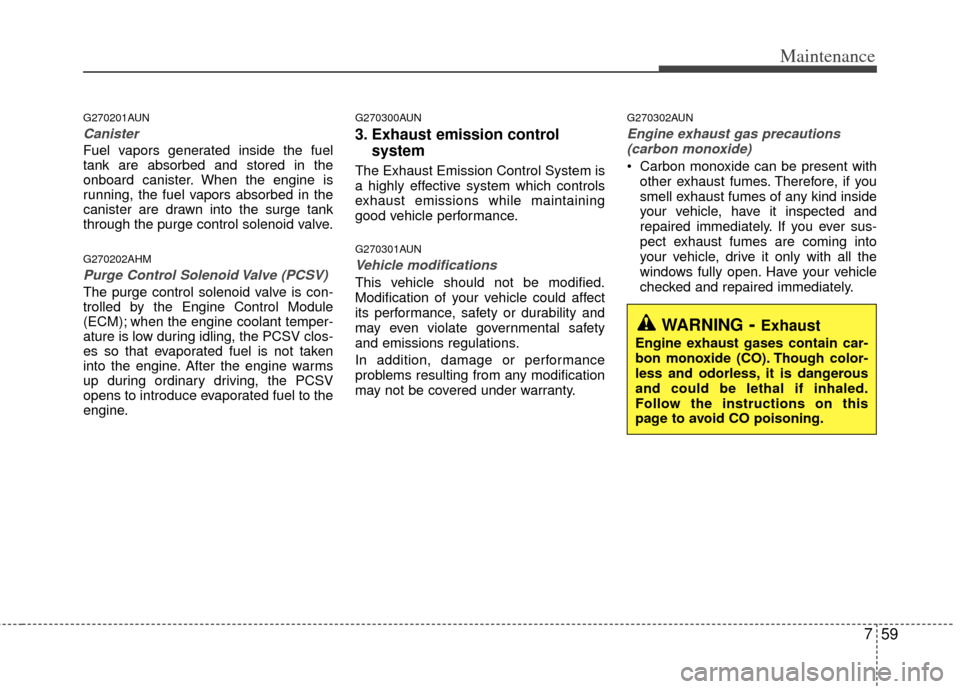
759
Maintenance
G270201AUN
Canister
Fuel vapors generated inside the fuel
tank are absorbed and stored in the
onboard canister. When the engine is
running, the fuel vapors absorbed in the
canister are drawn into the surge tank
through the purge control solenoid valve.
G270202AHM
Purge Control Solenoid Valve (PCSV)
The purge control solenoid valve is con-
trolled by the Engine Control Module
(ECM); when the engine coolant temper-
ature is low during idling, the PCSV clos-
es so that evaporated fuel is not taken
into the engine. After the engine warms
up during ordinary driving, the PCSV
opens to introduce evaporated fuel to the
engine.
G270300AUN
3. Exhaust emission control system
The Exhaust Emission Control System is
a highly effective system which controls
exhaust emissions while maintaining
good vehicle performance.
G270301AUN
Vehicle modifications
This vehicle should not be modified.
Modification of your vehicle could affect
its performance, safety or durability and
may even violate governmental safety
and emissions regulations.
In addition, damage or performance
problems resulting from any modification
may not be covered under warranty.
G270302AUN
Engine exhaust gas precautions
(carbon monoxide)
Carbon monoxide can be present with other exhaust fumes. Therefore, if you
smell exhaust fumes of any kind inside
your vehicle, have it inspected and
repaired immediately. If you ever sus-
pect exhaust fumes are coming into
your vehicle, drive it only with all the
windows fully open. Have your vehicle
checked and repaired immediately.
WARNING- Exhaust
Engine exhaust gases contain car-
bon monoxide (CO). Though color-
less and odorless, it is dangerous
and could be lethal if inhaled.
Follow the instructions on this
page to avoid CO poisoning.
Page 340 of 356
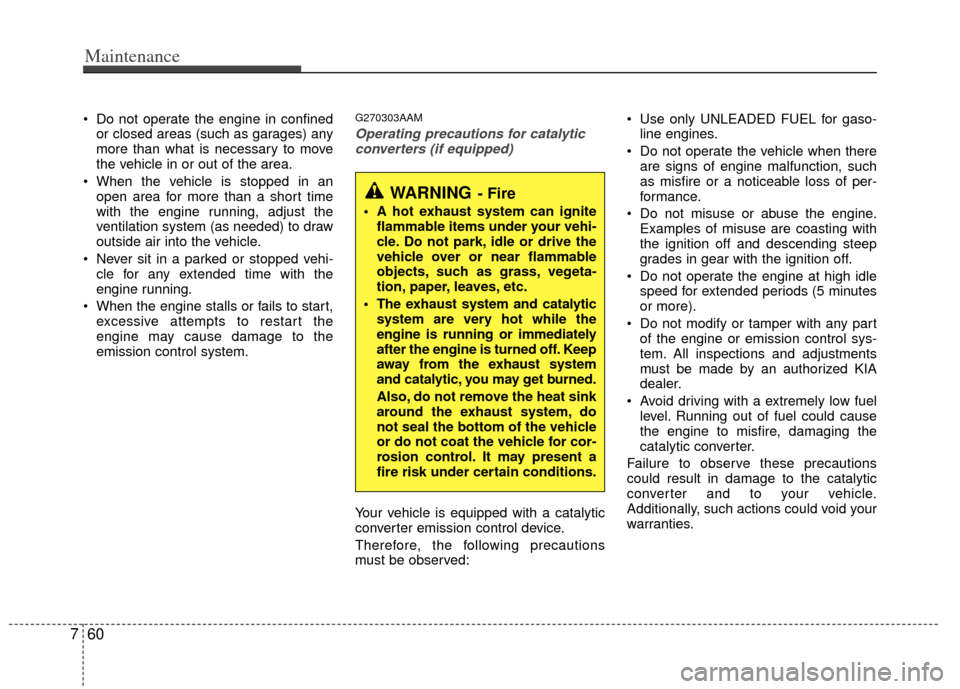
Maintenance
60
7
Do not operate the engine in confined
or closed areas (such as garages) any
more than what is necessary to move
the vehicle in or out of the area.
When the vehicle is stopped in an open area for more than a short time
with the engine running, adjust the
ventilation system (as needed) to draw
outside air into the vehicle.
Never sit in a parked or stopped vehi- cle for any extended time with the
engine running.
When the engine stalls or fails to start, excessive attempts to restart the
engine may cause damage to the
emission control system.G270303AAM
Operating precautions for catalyticconverters (if equipped)
Your vehicle is equipped with a catalytic
converter emission control device.
Therefore, the following precautions
must be observed: Use only UNLEADED FUEL for gaso-
line engines.
Do not operate the vehicle when there are signs of engine malfunction, such
as misfire or a noticeable loss of per-
formance.
Do not misuse or abuse the engine. Examples of misuse are coasting with
the ignition off and descending steep
grades in gear with the ignition off.
Do not operate the engine at high idle speed for extended periods (5 minutes
or more).
Do not modify or tamper with any part of the engine or emission control sys-
tem. All inspections and adjustments
must be made by an authorized KIA
dealer.
Avoid driving with a extremely low fuel level. Running out of fuel could cause
the engine to misfire, damaging the
catalytic converter.
Failure to observe these precautions
could result in damage to the catalytic
converter and to your vehicle.
Additionally, such actions could void your
warranties.
WARNING- Fire
A hot exhaust system can ignite flammable items under your vehi-
cle. Do not park, idle or drive the
vehicle over or near flammable
objects, such as grass, vegeta-
tion, paper, leaves, etc.
The exhaust system and catalytic system are very hot while the
engine is running or immediately
after the engine is turned off. Keep
away from the exhaust system
and catalytic, you may get burned.
Also, do not remove the heat sink
around the exhaust system, do
not seal the bottom of the vehicle
or do not coat the vehicle for cor-
rosion control. It may present a
fire risk under certain conditions.
Page 350 of 356

I3
Index
Child restraint system ··················\
··················\
················3-25Auto lock mode (Passenger seat belt) ··················\
·····3-28
Lower anchor system ··················\
··················\
············3-31
Tether anchor system··················\
··················\
·············3-30
Child-protector rear door lock ··················\
··················\
···4-16
Climate control system (Automatic) ··················\
···········4-77 Air conditioning ··················\
··················\
··················\
··4-83
Automatic heating and air conditioning··················\
··4-78
Manual heating and air conditioning ··················\
······4-69
Climate control system (Manual) ··················\
···············4-68 Air conditioning ··················\
··················\
··················\
··4-73
Heating and air conditioning··················\
··················\
·4-69
Climate control air filter ··················\
··················\
············4-75
Combined instrument, see instrument cluster ···············4-37
Compact spare tire ··················\
··················\
··················\
···6-23
Compact spare tire replacement ··················\
··················\
7-35
Coolant ··················\
··················\
··················\
··················\
···7-15
Cooling fluid, see engine coolant ··················\
················7-16
Crankcase emission control system ··················\
·············7-58
Cruise control system ··················\
··················\
················5-32
Cup holder ··················\
··················\
··················\
···············4-90
Curtain air bag ··················\
··················\
··················\
·········3-51
Dashboard, see instrument cluster ··················\
···············4-37
Defogging (Windshield) ··················\
··················\
············4-84
Defogging logic (Windshield) ··················\
··················\
···4-86
Defroster (Rear window) ··················\
··················\
···········4-67 Defrosting (Windshield) ··················\
··················\
············4-84
Dimensions ··················\
··················\
··················\
················8-2
Door locks··················\
··················\
··················\
················4-13
Central door lock switch ··················\
··················\
·······4-15
Child-protector rear door lock ··················\
················4-16
Drinks holders, see cup holders··················\
··················\
·4-90
Driver's air bag··············\
··················\
··················\
·············3-45
Driving at night··················\
··················\
··················\
········5-40
Driving in flooded areas ··················\
··················\
············5-41
Driving in the rain ··················\
··················\
··················\
···5-41
Economical operation ··················\
··················\
················5-36
Electric chromic mirror (ECM) ··················\
··················\
·4-33
Electronic stability control (ESC) ··················\
···············5-27
Emergency starting ··················\
··················\
··················\
····6-4 Jump starting ··················\
··················\
··················\
·········6-4
Push starting ··················\
··················\
··················\
··········6-5
Emergency tailgate safety release··················\
················4-18
Emergency towing ··················\
··················\
··················\
···6-27
Emergency while driving··················\
··················\
·············6-2
Emission control system ··················\
··················\
············7-58 Crankcase emission control system ··················\
········7-58
Evaporative emission control (including ORVR) System ··················\
··················\
··················\
··············7-58
Exhaust emission control system ··················\
············7-59
Engine compartment ··················\
··················\
············2-4, 7-2
Engine coolant ··················\
··················\
··················\
·········7-15
D
E
Page 351 of 356
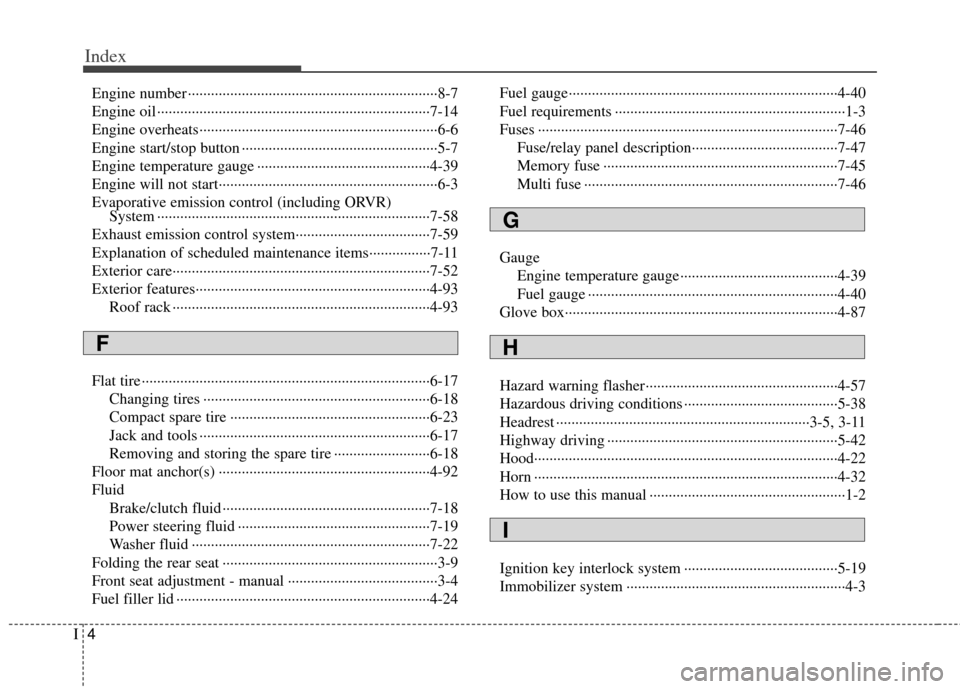
Index
4I
Engine number ··················\
··················\
··················\
···········8-7
Engine oil ··················\
··················\
··················\
·················7-14\
Engine overheats··················\
··················\
··················\
········6-6
Engine start/stop button ··················\
··················\
···············5-7
Engine temperature gauge ··················\
··················\
·········4-39
Engine will not start··················\
··················\
··················\
···6-3
Evaporative emission control (including ORVR) System ··················\
··················\
··················\
·················7-58\
Exhaust emission control system··················\
·················7-59\
Explanation of scheduled maintenance items················7-11
Exterior care··················\
··················\
··················\
·············7-52
Exterior features··················\
··················\
··················\
·······4-93 Roof rack ··················\
··················\
··················\
·············4-93
Flat tire ··················\
··················\
··················\
··················\
···6-17 Changing tires ··················\
··················\
··················\
·····6-18
Compact spare tire ··················\
··················\
················6-23
Jack and tools ··················\
··················\
··················\
······6-17
Removing and storing the spare tire ··················\
·······6-18
Floor mat anchor(s) ··················\
··················\
··················\
·4-92
Fluid Brake/clutch fluid ··················\
··················\
··················\
7-18
Power steering fluid ··················\
··················\
··············7-19
Washer fluid ··················\
··················\
··················\
········7-22
Folding the rear seat ··················\
··················\
··················\
··3-9
Front seat adjustment - manual ··················\
··················\
···3-4
Fuel filler lid ··················\
··················\
··················\
············4-24 Fuel gauge··················\
··················\
··················\
················4-40
Fuel requirements ··················\
··················\
··················\
······1-3
Fuses ··················\
··················\
··················\
··················\
······7-46
Fuse/relay panel description··················\
··················\
··7-47
Memory fuse ··················\
··················\
··················\
·······7-45
Multi fuse ··················\
··················\
··················\
············7-46
Gauge Engine temperature gauge··················\
··················\
·····4-39
Fuel gauge ··················\
··················\
··················\
···········4-40
Glove box··················\
··················\
··················\
·················4-87\
Hazard warning flasher··················\
··················\
··············4-57
Hazardous driving conditions ··················\
··················\
····5-38
Headrest ··················\
··················\
··················\
············3-5, 3-11
Highway driving ··················\
··················\
··················\
······5-42
Hood··················\
··················\
··················\
··················\
·······4-22
Horn ··················\
··················\
··················\
··················\
·······4-32
How to use this manual ··················\
··················\
···············1-2
Ignition key interlock system ··················\
··················\
····5-19
Immobilizer system ··················\
··················\
··················\
···4-3
F
G
H
I